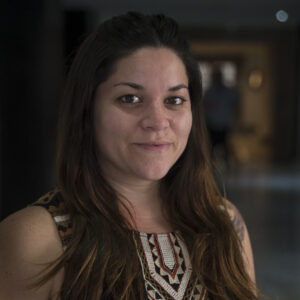Peruvian journalist Paola Ugaz has been the target of death threats online and legal cases following her investigations into the Sodalitium Christianae Vitae, a lay group of the Catholic Church founded in Peru.
Compared with her colleague Pedro Salinas, with whom she published the investigative book “Half monk, half soldiers,” she points out differences in how she is treated as a woman.
“Being a woman is a difference, my colleague Pedro [Salinas] is very aware, we have talked about it a lot. They messed with my body, my body is a place of entertainment, on social networks they said that my organs are not worth ten thousand soles,” she told LatAm Journalism Review (LJR). “Peruvian women journalists are always presented as servants, as if we have no agency. My intelligence and journalistic talent were questioned, my place in society was questioned. They messed with my private life, they talked about my family.”
Ugaz is not alone.
More than a third (38%) of women press workers recently surveyed in Latin America and the Caribbean said they were attacked online or on social networks and that the aggression was linked to their gender and journalistic work, according to a report from the International Federation of Journalists.
More than half of the women press workers surveyed in the region said they experienced gender violence from bosses and/or male colleagues, the report found.
Most said they didn’t have tools to address this kind of violence.

“Journalists and press workers are affected by gender violence in two dimensions,” states the report, prepared based on a survey of more than 300 women press workers in 15 Latin American and Caribbean countries.
The first is that they are women working in societies that are predominantly patriarchal. The second is that they are working as communicators subject to public opinion and attacks on freedom of expression.
This gender violence suffered by women press workers in the region, added to the job insecurity to which they are exposed, affects their day-to-day and quality of life, Paula Cejas, director of the IFJ Regional Office for Latin America and the Caribbean, told LatAm Journalism Review (LJR).
“There are colleagues who have suffered a lot of stress, who have had to leave work to take a break. They could not continue supporting their work life when they did not eat or sleep, as a result of the number of attacks they received and the job instability,” Cejas said. And she added that one of the consequences of gender violence is that female journalists “end up censoring themselves or using very lukewarm language.”
Cejas explained that the type of coverage that journalists do is one of the reasons that makes them the target of attacks: “The attacks on those who cover entertainment are not the same as those who cover politics, economics or security.”
When breaking down the data obtained from the survey by age groups, she added that female press workers over 61 years of age said they were more likely to suffer gender violence from male colleagues or bosses.
“These are numbers we don't usually see,” she said.
Job insecurity

Paula Cejas, director of the Regional Office for Latin America and the Caribbean of the International Federation of Journalists. (Courtesy: Paula Cejas)
In Latin America and the Caribbean, women journalists are not only attacked and harassed for gender reasons when carrying out their profession (inside the newsrooms where they work or publicly), but they also have high rates of job insecurity and take on extra jobs more often, according to the IFJ report.
Four out of every ten women press workers surveyed work in more than one media outlet at a time, and six out of ten take on jobs unrelated to their profession to supplement their income, the report found.
According to Cejas, the IFJ survey showed that Colombia and Mexico are the countries where the majority of the journalists surveyed said they had one or two journalistic jobs, in addition to another job outside of communication.
In turn, Cejas said that Central American journalists in particular are looking for freelance work.
“In Central America there is very little permanent work for journalists, who in many cases choose to be freelance to balance work with caring for their families, which allows them to have greater flexibility,” she said. “Also because it is understood that there are no guaranteed working conditions, whether it’s permanent work or freelance work.”
In these cases, Cejas said that female journalists are even more vulnerable, because they do not have “a space to turn to” or a media outlet that protects them against the gender violence they may suffer.
Suggestions for moving ahead
The IFJ report emphasizes the need to recognize gender violence against women press workers as a problem that affects the plurality of voices expressed in the media and democracy.
That is why it recommends that media and professional associations provide safe work spaces for women press workers. In addition, it says they should apply action protocols and ensure that they’re correctly implemented in situations of online attacks against women journalists.
In the case of women press workers, the IFJ said that 37% of those surveyed said that they are not affiliated with any union. For the organization, participation in these spaces is important because professionals can turn to them when faced with a problem.
“You have a place to turn and where there is someone who can defend you, a collective voice that represents you,” Cejas said.
The IFJ has a guide for unions and media outlets to combat online harassment of women journalists which can be consulted here in Spanish.